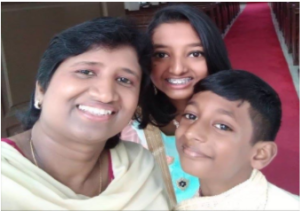
Saralah Devi Mariamdaram Chethiyar
Psychology & Counseling Programme, School of Applied Psychology, Social Work and Policy, College of Arts and Sciences, University Utara Malaysia
devi@uum.edu.my
Mohanamerry Vedamanikam
Ph.D. Candidate (Psychology), School of Applied Psychology, Social Work and Policy(SAPSP), College of Arts and Sciences, University Utara Malaysia
mohanamerry_vedam@ahsgs.uum.edu.my
The Coronavirus pandemic has led to mass lockdown in many countries, a measure taken by governments to fight this breakout and break the infection chain. It is not a war, not a natural disaster, not a reformation, and not a revolution. The entire world is involved and facing a moment of uncertainty. While we claim of being digitally connected, we are disconnected. As of this article written (25 April 2020), more than 200 countries have been impacted with more than 2.8 million globally infected while more than 200,000 have lost their life. In Malaysia, the total infected has surpassed 5000 while more than 90 have lost their life. The novel coronavirus initially emerged at Wuhan, Hubei Province, China in December 2019. Research indicated that this virus is airborne, droplets produced from the infected person during sneezing or coughing can spread to next person in close contact. The incubation period for this virus stated as 14 days, the duration for the virus to take effect. This new infectious disease was named Corona Virus Disease, COVID-19 by World Health Organization (WHO). Respiratory related symptoms such as dry cough, fever, and breathing difficulties are common signs of COVID-19. In severe cases, COVID-19 can cause severe acute respiratory syndrome, pneumonia, and death. WHO declared COVID 19 as pandemic on 11 March 2020.
Scientists and medical experts have been working very hard to invent a vaccine for this infectious virus. While that effort is progressing, a practical approach is essential to mitigate the spread of the virus and break the chain. Avoiding close contact or social distancing is crucial to achieving this objective. Schools, social and corporate meetings, functions, mass gatherings, traveling and many industries have been shut down to control the people’s movement. Places recorded with high infected cases were isolated to break the virus chain and enhanced MCO was implemented. Countries have declared lockdown or movement control in various methods, which requires everyone except essential services to stay at home and work from home. Malaysian government issued the first phase of movement control order (MCO) on 16 March 2020, effective until 30 March 2020. Schools, religious fellowships, non-essential industries were instructed to shut down with only essential services such as health, food, banking, and other specific sectors allowed to function. Incoming and outgoing flights were put on hold and Malaysians stranded overseas were brought back in special flights and quarantined for 14 days. As of this article written, the initial MCO has entered phase 4, extended until 12 May 2020. The main aspect of MCO and lockdown is the school from home and work from home, in summary, stay at home. Malaysia has gone through curfew in 1969 for security reasons and thereafter no such lockdown was recorded. For many Malaysians, this is the first experience of movement control and stay at home as the only option. Indeed, a culture shock, this article discusses the adoption of stay at the home phenomenon.

Live sharing and interview with Mohanamerry Vedamanikam and her wonderful family in her HOME SWEET HOME in Malaysia
Home sweet home, home is the place that gives us shelter and we live with our family members. In most cases, parents and children are out for work, school, and other activities. With traffic being heavy in the morning and after working hours, everyone is back home by 7 pm on weekdays. The weekend is when most everyone is at home and family activities become the focus. And the routine continuous. School holidays and festivals are the seasons’ everyone looks forward and enjoys the stay at home. At the end of school or festival holidays, everyone expects for additional days to stay at home. The initial MCO-stay at home was accepted as an interim measure, however, when the extensions were imposed with restrictions on business operation hours, limited entry to groceries/markets, limited movement radius, no social activities, no external entertainment, and school sessions via an internet platform, the perception on MCO-stay at home changed. Everyone understood the actual context of stay at home
Firstly, MCO-stay at home is not a holiday. The majority of working people were working from home via an online connection. Working parents had to be multitasking of taking care of their children, preparing meals and meet other needs of the children, including assisting them in their studies. Due to the movement limited to 10km radius, limited operation time for groceries, banking and food deliveries, and standing in a queue at the hypermarts and markets, parents were forced to manage their time between work, home, and external activities. As only one person allowed to be out for external activities, stopped at roadblocks for verification, and unable to get all the required items at the nearby shops were among the challenges contributed towards stress. The household items were finishing much faster due to high usage and had to be replenished. Air-conditions and electrical items usage were maximized, and some resulted in repairs. High internet usage required the purchase of additional data plan to cater to all the online access required. The above is entirely new to parents and has never occurred during the usual school or festival holidays. For many parents, this is a 360 degrees change, physical and mentally challenged them.
Secondly, students were among the next category who had the MCO-stay at home culture shock. Students also came to realize; this is not considered a holiday. They were given assignments on online learning platforms such as google classroom, google meet, and Zoom video conferencing. They had due dates to meet. They are not allowed to play at the playground. They have not met their friends and only chat via calls. They need to share their belongings with their siblings, share the computer, share the study table, and stationaries. Sharing is caring but at times it results in quarrels and arguments. During school time, most of the work completed in school, and certain homework is done at home. Now, all the work is done at home, a new culture the students had to adopt. Initial online assignments were fun but along the way, students unable to adopt long-term online learning and wanted to go back to school. Confined within the walls was a tremendous mental challenge for students.
While there were elements of culture shock and stress, there were also good moments between parents and children. Mothers started to venture into new recipes, new home games were invented such as home treasure hunt, communication between parents and children increased addressing the communication gaps, and all the activities in the house involved everyone. A different dimension of family bondage being realized.
Everything needs a first-time occurrence. When MCO was initially announced, there were panic buying and many questions in everyone’s mind. However, along the way, everyone started to learn the context, expectations, and limitations and crafted alternate solutions required to address the issues cropped. while the MCO and stay at home were circuit breakers of the virus, it is also seen as a psychological journey for Malaysians and other countries as well. It is another dimension of socio-culture and adopting into our lifestyle. There were 2 main learnings psychologically adopted. Firstly, the MCO and stay at home are for our benefit, to avoid the spread of the virus and end the virus war at a quicker pace. Secondly, stay at home is manageable from the aspect of work from home, school from home, food, and household items.
We don’t expect another pandemic to stay at home but when it happens, the psychological SOP is ready to be executed. We are given daily updates by the government on the status, indicating the progress we have made through the MCO initiatives. However, are we comfortable to end our stay at home in the event no vaccine has been found for this virus?





